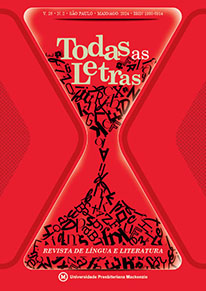Inteligência artificial e enunciação:
análise de grandes coleções de imagens e geração automática via Midjourney
Palavras-chave:
Big Visual data, Enunciação, Geração automática de imagens, Inteligência ArtificialDownloads
Referências
BENVENISTE, É. Problems in general linguistics. Miami: University of Miami Press, 1971.
BEYAERT-GESLIN, A. Sémiotique du portrait: De Dibutade au selfie. Louvain-la-Neuve: De Boeck Supérieur, 2017.
COLAS-BLAISE, M. Comment penser la narrativité dans l’image fixe? La “composition cinétique” chez Paul Klee. Pratiques, n. 181-182, p. 1-15, 2019. Disponível em: http://journals.openedition.org/pratiques/6097. http://journals.openedition.org/pratiques/6097. Acesso em: jun.2024.
DONDERO, M. G. The semiotics of design in media visualization: mereology and observation strategies. Information Design Journal, v. 23, n. 2, p. 208-218, 2017. DOI: https://doi.org/10.1075/idj.23.2.09don.
DONDERO, M. G. Le travail des algorithmes. Quelques réflexions sur l’actantialité et l’énonciation. In: CONFERÊNCIA DA AFS, 10 jun. 2019a. Lyon, Université de Lyon 2, org. Pierluigi BASSO. Disponível em: https://core.ac.uk/outputs/220155468/. Acesso em: jun. 2024.
DONDERO, M. G. Visual semiotics and automatic analysis of images from the Cultural Analytics Lab: how can quantitative and qualitative analysis be combined? Semiotica, v. 230, p. 121-142, 2019b. DOI: https://doi.org/10.1515/ sem-2018-0104.
DONDERO, M. G. The language of images. The forms and the forces. Cham:
Springer, 2020.
DONDERO, M. G. Emerging faces: the figure-ground relation from renaissance painting to deepfakes. In: LEONE, M. (org.). The hybrid face: paradoxes of the visage in the digital era. London: Routledge, 2023. p. 74-86.
DONDERO, M. G. The face: between background, enunciative temporality and status. Reti, Saperi, Linguaggi: The Italian Journal of Cognitive Sciences, 1, a. 13 (25), p. 49-70, 2024.
DONDERO, M. G. Semiótica da inteligência artificial: análise computacional de grandes bases de dados e geração automática de imagens. Matrizes, 2025.
ECO, U. Semiotica e filosofía del linguaggio. Torino: Einaudi, 1984.
FOCILLON, H. Vie de formes. Paris: Presses Universitaires de France, 1934.
FONTANILLE, J. Les espaces subjectifs. Introduction à la sémiotique de l’observateur. Paris: Hachette, 1989.
FONTANILLE, J. Sémiotique et littérature. Essais de méthode. Paris: Presses Universitaires de France, 1998.
FONTANILLE, J. Sémiotique du discours. Limoges: Presses Universitaires de Limoges, 1999.
FONTANILLE, J. Semiótica do discurso. Tradução Jean Cristtus Portela. São Paulo: Contexto, 2015.
GOODMAN, N. Languages of art: an approach to a theory of symbols. Indianapolis: Hackett Publishing Company, 1976.
GREIMAS, A.J. Sémiotique figurative et sémiotique plastique. Actes sémiotiques.
Document VI, 1984.
GREIMAS, A. J. Du sens II. Paris: Seuil, 1983.
GROUPE μ. L’effet de temporalité dans les images fixes. Texte, n. 21-22, p. 41-69,1998.
KEMENY, J. G.; KURTZ, T. E. Introduction to Basic: programming language. New York: Wiley, 1964.
KERNIGHAN, B. W.; PLAUGER, P. J. Elements of programming style. 2. ed. New York: McGraw-Hill, 1978.
KNUTH, D. E. The TeXbook. Reading: Addison-Wesley, 1984.
LASSÈGUE, J. Turing. Tradução Guilherme J. F. Teixeira. São Paulo: Estação
Liberdade, 2017.
LIEN, J. The Basic handbook. New York: McGraw-Hill, 1981.
LOPES, C. V. Exercises in programming styles. Boca Raton: CRC Press, 2014.
MANOVICH, L. Cultural analytics. Cambridge: MIT Press, 2020.
MANOVICH, L.; ARIELLI, M. Artificial aesthetics: generative AI, art and visual media. 2021-2024. Disponível em: http://manovich.net/index.php/projects/artificial-aest hetics. Acesso em: jan. 2024.
MARIN, L. De la représentation. Paris: Seuil, 1993.
PETITOT, J. Morphologie et esthétique. Paris: Maisonneuve et Larose, 2004.
QUENEAU, R. Exercises in style. Paris: Gallimard, 1947.
TANAKA-ISHII, K. Semiotics of programming. Cambridge: Cambridge University Press, 2010.
THOM, R. Local et global dans l’oeuvre d’art. Le Débat, v. 2, n. 24, p. 73-89, 1983.
TURING, A. M. On Computable Numbers, with an Application to the Entscheidungsproblem. Proceedings of the London Mathematical Society, v. 45, p. 230-265,1936.
TURING, A. M. Computing machinery and intelligence. Mind, v. 59, n. 236, p. 433-460, 1950.
VALLE, A. Entrevista concedida a Pierluigi Basso e Maria Giulia Dondero. In:
BASSO, P.; COLAS-BLAISE, M.; DONDERO, M. G. (org.). La communication à l’épreuve du geste numérique. MEI, Médiation et Information, n. 49, p. 45-56, 2019a.
VALLE, A. On a fragment of Basic code in Foucault’s Pendulum by Umberto Eco. Lexia, n. 32, 2019b.
VALLE, A.; MAZZEI, A. Sapir-Whorf vs. Boas-Jakobson. Enunciation and the semiotics of programming languages. ACADEMIA, 2017. Disponível em: https://www.academia.edu/36681676/Sapir_Whorf_vs_Boas_Jakobson_Enunciation_and_the_Semi tics_of_Programming_Languages. Acesso em: mar. 2024.
WARBURG, A. L’atlas Mnémosyne. Paris: Éditions Atelier de l’écarquillé, 2012.
Downloads
Publicado
Como Citar
Edição
Seção
Licença
Copyright (c) 2024 Maria Giulia Dondero ; Gustavo Henrique Rodrigues de Castro, Matheus Nogueira Schwartzmann

Este trabalho está licenciado sob uma licença Creative Commons Attribution-NonCommercial 4.0 International License.
Os direitos autorais dos artigos publicados na Todas as Letras pertencem aos autores, que concedem à Universidade Presbiteriana Mackenzie os direitos exclusivos de publicação do conteúdo. É vedada sua reprodução total ou parcial sem a devida autorização da Comissão Editorial, exceto para estudo e pesquisa.




